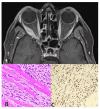Ocular and Periocular Metastasis in Breast Cancer: Clinical Characteristics, Prognostic Factors and Treatment Outcome
- PMID: 38672600
- PMCID: PMC11048436
- DOI: 10.3390/cancers16081518
Ocular and Periocular Metastasis in Breast Cancer: Clinical Characteristics, Prognostic Factors and Treatment Outcome
Abstract
Background: Breast cancer remains a leading cause of cancer-related mortality and morbidity worldwide. Ocular and periocular metastasis present as a rare but clinically significant manifestation. This study aims to explore demographics and clinical aspects of ocular and periocular metastasis in breast cancer patients.
Methods: A retrospective cohort study comprising 45 breast cancer patients with ocular or periocular metastasis treated between 2013 and 2023. Patient demographics, tumor characteristics, diagnostic methods, treatment modalities, visual outcomes, and survival data were analyzed.
Results: Among 9902 breast cancer patients, 0.5% developed ocular or periocular metastasis, constituting 2.4% of metastatic cases. The median age was 50 years. Ocular metastasis timing varied: 5% before breast cancer, 24% concurrent, 22% within a year, and 49% after. The most common presentations included incidental MRI findings (42%) and vision decline (31%). Metastasis involved the orbit (47%), choroid (40%), optic nerve (11%), and iris (2%), with 44% having bilateral involvement. Predictive factors included invasive lobular carcinoma (ILC) (p < 0.0001) and brain metastasis (p < 0.0001), with ILC exhibiting a sixfold higher likelihood of ocular metastasis than invasive ductal carcinoma (IDC). Primary treatment was radiation therapy (89%), yielding a 55% maintenance of excellent vision (<0.5), with 93% developing dry eye disease. Patients with ocular metastasis faced an increased risk of disease-related mortality (p < 0.0001), with 71% succumbing within 10 months post-diagnosis.
Conclusions: Ocular metastasis in breast cancer is rare (0.5%) but signifies poor outcome. It is linked to ILC and concurrent brain metastasis. Primary treatment involves radiation therapy, with a favorable visual prognosis.
Keywords: breast cancer; choroidal metastasis; ocular metastasis; periocular metastasis; treatment outcomes.
Conflict of interest statement
The authors declare no conflicts of interest.
Figures



Similar articles
-
From Breast to Eye: A Rare Case of Ocular Metastasis From Luminal Breast Cancer in a Nicaraguan Patient.Cureus. 2025 Mar 17;17(3):e80748. doi: 10.7759/cureus.80748. eCollection 2025 Mar. Cureus. 2025. PMID: 40248531 Free PMC article.
-
Uveal Melanoma Metastasis to the Contralateral Eye Structures: A Retrospective Comparative Analysis of 13 Consecutive Patients.Ophthalmol Retina. 2021 Oct;5(10):1036-1042. doi: 10.1016/j.oret.2020.12.025. Epub 2021 Jan 7. Ophthalmol Retina. 2021. PMID: 33421627
-
Patient treatment and outcome after breast cancer orbital and periorbital metastases: a comprehensive case series including analysis of lobular versus ductal tumor histology.Breast Cancer Res. 2020 Jun 26;22(1):70. doi: 10.1186/s13058-020-01309-3. Breast Cancer Res. 2020. PMID: 32586354 Free PMC article.
-
Comprehensive Review of Molecular Mechanisms and Clinical Features of Invasive Lobular Cancer.Oncologist. 2021 Jun;26(6):e943-e953. doi: 10.1002/onco.13734. Epub 2021 Mar 16. Oncologist. 2021. PMID: 33641217 Free PMC article. Review.
-
Invasive lobular carcinoma: an understudied emergent subtype of breast cancer.Breast Cancer Res Treat. 2022 Jun;193(2):253-264. doi: 10.1007/s10549-022-06572-w. Epub 2022 Mar 26. Breast Cancer Res Treat. 2022. PMID: 35347549 Review.
Cited by
-
Perineural Invasion in Breast Cancer: A Comprehensive Review.Cancers (Basel). 2025 Jun 6;17(12):1900. doi: 10.3390/cancers17121900. Cancers (Basel). 2025. PMID: 40563551 Free PMC article. Review.
-
From Breast to Eye: A Rare Case of Ocular Metastasis From Luminal Breast Cancer in a Nicaraguan Patient.Cureus. 2025 Mar 17;17(3):e80748. doi: 10.7759/cureus.80748. eCollection 2025 Mar. Cureus. 2025. PMID: 40248531 Free PMC article.
References
-
- World Health Organization, Breast Cancer Facts. [(accessed on 16 February 2024)]. Available online: https://www.who.int/news-room/fact-sheets/detail/breast-cancer.
-
- Pestalozzi B.C., Zahrieh D., Mallon E., Gusterson B.A., Price K.N., Gelber R.D., Holmberg S.B., Lindtner J., Snyder R., Thürlimann B., et al. International Breast Cancer Study Group: Distinct clinical and prognostic features of infiltrating lobular carcinoma of the breast: Combined results of 15 International Breast Cancer Study Group clinical trials. J. Clin. Oncol. 2008;26:3006–3014. doi: 10.1200/JCO.2007.14.9336. - DOI - PubMed
LinkOut - more resources
Full Text Sources

